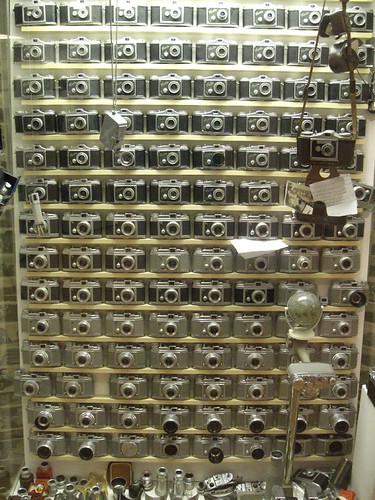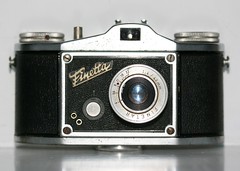Difference between revisions of "Finetta"
(minor grammar, formatting; fixed broken Halgand link) |
m (→Finettas, 1949 to 1951: typo) |
||
| Line 19: | Line 19: | ||
===Finettas, 1949 to 1951=== | ===Finettas, 1949 to 1951=== | ||
*1949: '''Finetta III D''': tube lens Anastigmat Finetar 1:4/43mm, wide aperture range - f/4-f/22, distance selectable | *1949: '''Finetta III D''': tube lens Anastigmat Finetar 1:4/43mm, wide aperture range - f/4-f/22, distance selectable | ||
| − | *1950: '''Finetta IV D''': as III D, but with variable speed shutter; some had a 1<sup>5</sup>/<sub>8</sub>inch lens (labelled in inches, ~ | + | *1950: '''Finetta IV D''': as III D, but with variable speed shutter; some had a 1<sup>5</sup>/<sub>8</sub>inch lens (labelled in inches, ~41mm) |
*1950: '''Finetta IV D''': version with exchangeable lenses for 27mm lens mount, four lenses available | *1950: '''Finetta IV D''': version with exchangeable lenses for 27mm lens mount, four lenses available | ||
*1951: '''Finetta Super''': First camera with hot shoe | *1951: '''Finetta Super''': First camera with hot shoe | ||
Revision as of 19:55, 18 April 2008

|
| snub-nosed Finetta, the renamed Finette |
The Finetta-Werk in Goslar, Harz (Germany) had been founded by Piet Sarabèr, a Dutch native, born in 1899 in Delft. He was an electrician and studied engineering, and married a German woman. In 1942 he moved to Germany, where he opened a company in 1945 as an engineering consultant with focus on electricity. Beside the company's focus it developed cameras. In 1947 a cooperation with Helmut Finke began. Finke was a former constructor at Voigtländer, Braunschweig. Until 1948 they developed the Finette 35mm viewfinder cameras, which were launched in 1949.

|
| an astounding collection |
Contents
Finettes of 1949
- 1. Finette I A: 43mm meniscus lens, fixfocus, one aperture, 1/30 sec.
- 2. Finette II A: as I A, but aperture 6.3 to 16
- 3. Finette I B and II B: Finar 1:5.6/43mm achromatic lens, body improved
- 4. renamed to Finetta I D and II D
Finettas, 1949 to 1951
- 1949: Finetta III D: tube lens Anastigmat Finetar 1:4/43mm, wide aperture range - f/4-f/22, distance selectable
- 1950: Finetta IV D: as III D, but with variable speed shutter; some had a 15/8inch lens (labelled in inches, ~41mm)
- 1950: Finetta IV D: version with exchangeable lenses for 27mm lens mount, four lenses available
- 1951: Finetta Super: First camera with hot shoe
camera sophistication period
In 1951 Rudolf Trentsch, former camera constructor at Korelle, Dresden, camera constructor Karl-Heinz Reich from REKA-Kamera, Jena, and camera constructor H. Höhlemann entered the Finetta-Werk.
In 1952 the camera developments reached a peak with the Finetta 99, with clockwork wind-on, fast focal plane shutter, bayonet mount, hot shoe, and 3 new lenses (45mm, 70mm, and 105mm). In the U.S. the camera was sold as Ditto 99.
In 1953, camera production reached industrial dimensions. The Finetta Super was replaced by the Finetta 88, with a new bayonet and the body of the Finetta 99.
new horizons and end
In 1954 the company began a cooperation with Jacques Bogopolsky alias Jacques Bolsey which resulted in the exciting subminiature 8mm cine-film camera, the Bolsey 8.
In 1956 the company got into insolvency. The factory was closed in 1957.

|
| the more sophisticated Finetta IV |
Links
- Finetta on ukcamera.com
- Finetta at www.collection-appareils.com